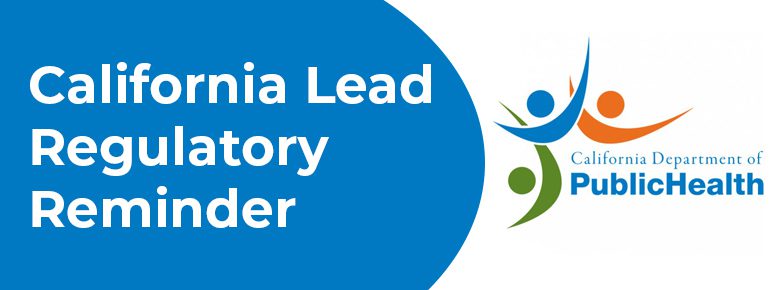
2024 CDPH Lead Regulatory Changes
- Allison Croulet
- April 4, 2023
- 8:52 am
The California Department of Public Health (CDPH) has recently proposed new regulations to further protect children and adults from the harmful effects of lead exposure. The proposed regulations, which are expected to take effect in 2024, aim to reduce lead exposure in high-risk populations and environments across the state.
Lead is a toxic substance that can cause serious health problems, especially in children. Exposure to lead can result in developmental delays, behavioral problems, and learning difficulties. In adults, lead exposure can lead to high blood pressure, kidney damage, and reproductive problems.
The proposed regulations build on the existing regulations that were put into effect on July 1, 2021, which lowered the blood lead level at which public health actions are required from 10 micrograms per deciliter (µg/dL) to 5 µg/dL. The proposed regulations also expand the scope of lead testing requirements and further limit lead exposure in various settings.
One key provision of the proposed regulations is the expansion of lead testing requirements to include all licensed child care facilities and homes that provide in-home child care. This will ensure that children in these settings are protected from the harmful effects of lead exposure. The proposed regulations also require that all children in these settings are tested for lead exposure at least once by age 2, and that follow-up testing is conducted as needed.
In addition, the proposed regulations require the testing of all water faucets and fixtures in all licensed child care facilities and schools built before 2010. If lead is found in the water at levels above the state’s action level, which is currently set at 5 µg/dL, corrective actions must be taken to reduce or eliminate the lead exposure.
The proposed regulations also require that all residential rental properties built before 1978, which is when lead paint was banned, be tested for lead hazards before new tenants move in. If lead hazards are found, landlords must take corrective actions to eliminate them.
Another key provision of the proposed regulations is the requirement that all health care providers in California screen children for lead exposure at least once by age 2, and that follow-up testing is conducted as needed. This will help to ensure that children at high risk of lead exposure are identified and receive appropriate care.
The CDPH has stated that these proposed regulations are an important step forward in protecting public health from the harmful effects of lead exposure. By expanding lead testing requirements and limiting lead exposure in various settings, the state can identify and prevent lead exposure in high-risk populations and environments.
However, some critics have raised concerns about the potential costs associated with the proposed regulations. For example, landlords may need to invest in lead hazard remediation in order to comply with the regulations, which could be a significant expense for some.
Overall, the proposed CDPH regulations represent an important step forward in protecting public health from the harmful effects of lead exposure. By expanding lead testing requirements and limiting lead exposure in various settings, the state can identify and prevent lead exposure in high-risk populations and environments. The regulations are currently under review and are expected to take effect in 2024.
We are asking all NATEC instructors to review these regulation changes and proposed changes and to be able to effectively discuss it in classes. We are on standby for any questions or feedback.
Sincerely,
Allison Croulet
Vice President

